i-ACTIVSENSE
i-ACTIVSENSE (Some Models)
i-ACTIVSENSE is a collective term covering a series of advanced safety and driver support systems which make use of a Forward Sensing Camera (FSC) and radar sensors. These systems consist of active safety and pre-crash safety systems.
These systems are designed to assist the driver in safer driving by reducing the load on the driver and helping to avert collisions or reduce their severity. However, because each system has its limitations, always drive carefully and do not rely solely on the systems.
Manual Switching
Switching to low beams
Shift the lever to the low beam position.
The HBC indicator light (green) turns off.
Switching to high beams
Turn the headlight switch to the  position.
position.
The HBC indicator light (green) turns off and the  is illuminated.
is illuminated.
Traffic Sign Display Indication
The following traffic signs are displayed on the active driving display.
Speed limit signs

Do not enter signs

Stop signs

Speed limit signs
-
When the vehicle speed is about 1 km/h (0.6 mph) or faster, the speed limit sign is displayed when any one of the following conditions are met.
-
The Forward Sensing Camera (FSC) recognizes a speed limit sign as a sign targeted for your vehicle and the vehicle passes it.
-
The speed limit sign stored in the navigation system is read (if the Forward Sensing Camera (FSC) does not recognize a speed limit sign).
-
-
In the following cases, display of the speed limit sign stops.
-
The Forward Sensing Camera (FSC) recognizes the speed limit sign and the vehicle is driven for a certain distance after passing the sign.
-
Each sensor determines that the vehicle has changed direction of travel.
-
The Forward Sensing Camera (FSC) recognizes a new speed limit sign which differs from the previous one (displays the new speed limit sign).
-
The speed limit sign stored in the navigation system is not read within a certain period of time (if the Forward Sensing Camera (FSC) does not recognize a speed limit sign, the speed limit sign stored in the navigation system is displayed).
-
The vehicle speed exceeds the displayed speed limit sign by 30 km/h (19 mph) or more after a certain period of time has elapsed since the speed limit sign was displayed. (Except when there is information for the speed limit sign in the navigation system)
-
Do not enter signs
-
A do not enter sign is displayed when all of the following conditions are met.
-
The vehicle speed is about 60 km/h (37 mph) or slower.
-
The Forward Sensing Camera (FSC) recognizes a do not enter sign as a sign targeted for your vehicle and the vehicle passes it.
-
-
When the Forward Sensing Camera (FSC) recognizes the do not enter sign and a certain period of time has elapsed since the vehicle passed the sign, display of the do not enter sign stops.
Stop sign
-
A stop sign is displayed when all of the following conditions are met:
-
The vehicle speed is about 30 km/h (19 mph) or slower.
-
The Forward Sensing Camera (FSC) recognizes a stop sign as a sign targeted for your vehicle.
-
-
When a certain period of time has elapsed since the stop sign was displayed, display of the stop sign stops.
Indication on Display
The DRSS operation status is indicated in the multi-information display. Regarding malfunctions, check the vehicle conditions or have it inspected by an Authorized Mazda Dealer according to the content of the displayed message.
-
When the ignition is switched off, the operation status before the system was turned off is maintained. For example, if the ignition is switched off with the DRSS operable, the system will be operable when the ignition is switched ON the next time.
-
The DRSS can be turned on/off and the system's sensitivity can be changed.
Refer to the Settings section in the Mazda Connect Owner's Manual.
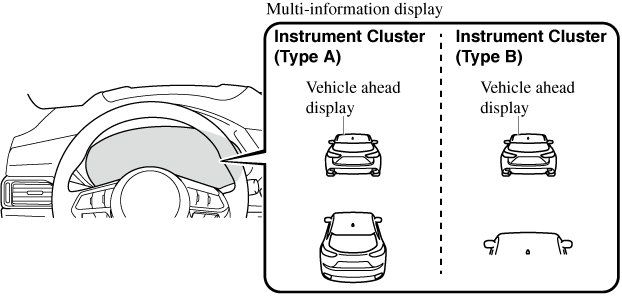
Distance-between-vehicles guide lines*1
|
Indication on display |
Distance between vehicles guide lines (During travel at about 40 km/h (25 mph) |
Distance between vehicles guide lines (During travel at about 80 km/h (50 mph) |
|
|---|---|---|---|
|
Multi-information display |
|||
|
Instrument cluster (Type A) |
Instrument cluster (Type B) |
||
 |
 |
About 25 m (82 ft) |
About 50 m (164 ft) |
 |
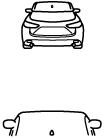 |
About 20 m (66 ft) |
About 40 m (131 ft) |
 |
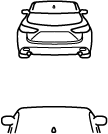 |
About 15 m (49 ft) |
About 30 m (98 ft) |
 |
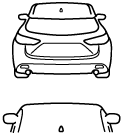 |
About 10 m (33 ft) |
About 20 m (66 ft) |
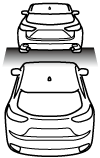 Illuminated in amber*2 |
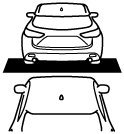 Illuminated in amber*2 |
About 10 m (32 ft) or less |
About 20 m (65 ft) or less |
-
The distance between vehicles differs depending on vehicle speed.
-
Indication when the distance setting for notifying the driver that the vehicle approaches a vehicle ahead is Near.
Rear Cross Traffic Alert (RCTA) (Some Models)
The RCTA system is designed to assist the driver in checking the area to the rear of the vehicle on both sides while the vehicle is reversing by alerting the driver to the presence of vehicles approaching the rear of the vehicle.
The RCTA system detects vehicles approaching from the rear left and right sides of the vehicle, and the rear of the vehicle while the vehicle is being reversed out of a parking space, and notifies the driver of possible danger using the Blind Spot Monitoring (BSM) warning indicator lights and the warning buzzer.
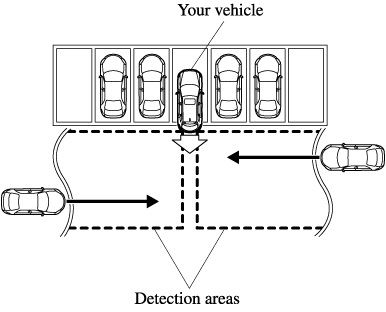
RCTA operation
-
The RCTA system operates when the selector lever is shifted to the reverse (R) position.
-
If there is the possibility of a collision with an approaching vehicle, the Blind Spot Monitoring (BSM) warning indicator lights flashes and the warning beep is activated simultaneously.
(With rear view monitor)
The RCTA warning indication in the rearview monitor also synchronizes with the Blind Spot Monitoring (BSM) warning indicator light on the door mirrors.
(With 360° view monitor)
The RCTA warning indication in the 360° view monitor also synchronizes with the Blind Spot Monitoring (BSM) warning indicator light on the door mirrors.

Always check the surrounding area visually before actually putting the vehicle in reverse:
The system is only designed to assist you in checking for vehicles at the rear when putting the vehicle in reverse. Due to certain limitations with the operation of this system, the Blind Spot Monitoring (BSM) warning indicator lights may not flash or it might be delayed even though a vehicle is behind your vehicle. Always make it your responsibility as a driver to check the rear.
-
In the following cases, the Blind Spot Monitoring (BSM) OFF indicator light turns on and operation of the system is stopped. If the Blind Spot Monitoring (BSM) OFF indicator light remains illuminated, have the vehicle inspected at an Authorized Mazda Dealer as soon as possible.
-
Some problem with the system including the Blind Spot Monitoring (BSM) warning indicator lights has occurred.
-
A large deviation in the installation position of a radar sensor (rear) on the vehicle has occurred.
-
There is a large accumulation of snow or ice on the rear bumper near a radar sensor (rear).
-
Driving on snow-covered roads for long periods.
-
The temperature near the radar sensors becomes extremely hot due to driving for long periods on slopes during the summer.
-
The battery voltage has decreased.
-
-
Under the following conditions, the radar sensors (rear) cannot detect target objects or it may be difficult to detect them.
-
The vehicle speed when reversing is about 15 km/h (9 mph) or faster.
-
The radar sensor (rear) detection area is obstructed by a nearby wall or parked vehicle. (Reverse the vehicle to a position where the radar sensor detection area is no longer obstructed.)

-
A vehicle is approaching directly from the rear of your vehicle.

-
The vehicle is parked at an angle.

-
Directly after the Blind Spot Monitoring (BSM) system becomes operable using the personalization feature.
-
Radio wave interference from a radar sensor equipped on a nearby parked vehicle.
-
-
In the following cases, it may be difficult to view the illumination/flashing of the Blind Spot Monitoring (BSM) warning indicator lights equipped on the door mirrors.
-
Snow or ice adheres to the door mirrors.
-
The front door glass is fogged or covered in snow, frost or dirt.
-
-
Turn off the RCTA system while pulling a trailer or while an accessory such as a bicycle carrier is installed to the rear of the vehicle. Otherwise, the radio waves emitted by the radar will be blocked causing the system to not operate normally.
Lane-keep Assist System (LAS) & Lane Departure Warning System (LDWS) (Some Models)
The LAS & LDWS alerts the driver that the vehicle may be deviating from its lane and it provides steering assistance to help the driver stay within the vehicle lanes.
The Forward Sensing Camera (FSC) detects the white lines (yellow lines) of the vehicle lane in which the vehicle is traveling and if the system determines that the vehicle may deviate from its lane, it operates the electric power steering to assist the driver's steering operation. The system also alerts the driver by activating a lane departure warning sound, vibrating the steering wheel, and indicating an alert in the display. Use the system when you drive the vehicle on roads with white (yellow) lines such as expressways and highways.
Refer to Forward Sensing Camera (FSC) (Search).
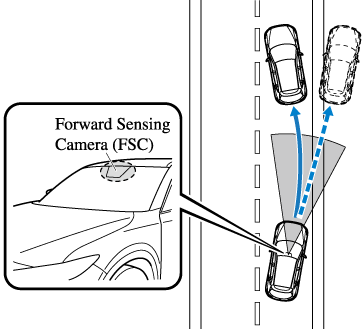
Do not rely completely on the LAS & LDWS:
-
The LAS & LDWS is not an automatic driving system. In addition, the system is not designed to compensate for a driver's lack of caution, and over-reliance on the system could lead to an accident.
-
The detection ability of the LAS & LDWS is limited. Always stay on course using the steering wheel and drive with care.
Do not use the LAS & LDWS in the following cases:
The system may not operate adequately according to the actual driving conditions, resulting in an accident.
-
Driving on roads with tight curves.
-
Driving under bad weather conditions (rain, fog, and snow).
-
Slippery roads such as ice or snow-bound roads.
-
Roads with heavy traffic and insufficient distance between vehicles.
-
Roads with no white (yellow) lane lines.
-
Narrow roads resulting from road construction or lane closures.
-
The vehicle is driven on a temporary lane or section with a closed lane resulting from road construction where there may be multiple white (yellow) lane lines or they are interrupted.
-
Vehicle is driven on roads other than expressways and highways.
-
The tire pressures are not adjusted to the specified pressure.
-
The vehicle is being used to tow a camper or boat trailer.
-
Tires of a different specified size are used, such as an emergency spare tire.
Heed the following cautions so that the LAS & LDWS can operate normally.
-
Do not modify the suspensions.
-
Always use wheels of the specified type and size for the front and rear wheels. Consult an Authorized Mazda Dealer for tire replacement.
-
When the turn signal lever is operated for a lane change, the LAS & LDWS is automatically disabled. The LAS & LDWS becomes operational again when the turn signal lever is returned and the system detects white (yellow) lane lines while the vehicle is being driven normally within its vehicle lane.
-
If the steering wheel, accelerator pedal, or brake pedal is operated abruptly and the vehicle moves close to a white (yellow) line, the system determines that the driver is making a lane change and the LAS & LDWS operation is temporarily canceled. The LAS & LDWS becomes operational again when the system detects white (yellow) lane lines while the vehicle is being driven normally within its vehicle lane.
-
If the vehicle deviates from its lane repeatedly within a short period of time, the LAS & LDWS may not operate.
-
When white (yellow) lane lines are not detected, the LAS & LDWS does not operate.
-
Under the following conditions, the LAS & LDWS may not be able to detect white (yellow) lane lines correctly and it may not operate normally.
-
If an object placed on the dashboard is reflected in the windshield and picked up by the camera.
-
Heavy luggage is loaded in the luggage compartment or on the rear seat and the vehicle is tilted.
-
The tire pressures are not adjusted to the specified pressure.
-
Tires other than conventional tires are equipped.
-
Vehicle is driven on an intersection or junction, or on a forked road.
-
The white (yellow) lane lines are less visible because of dirt or fading/patchiness.
-
A vehicle in front of your vehicle is running near a white (yellow) lane line making it less visible.
-
A white (yellow) lane line is less visible because of bad weather (rain, fog, or snow).
-
The vehicle is driven on a temporary lane or section with a closed lane resulting from construction where there may be multiple white (yellow) lane lines or they are interrupted.
-
A misleading line is picked up on the road such as a temporary line for construction, or because of shade, lingering snow, or grooves filled with water.
-
The surrounding brightness suddenly changes such as when entering or exiting a tunnel.
-
The illumination of the headlights is weakened because of dirt or the optical axis is deviated.
-
The windshield is dirty or foggy.
-
The windshield, camera is fogged (water droplets).
-
Back-light is reflected off the road surface.
-
The road surface is wet and shiny after rain, or there are puddles on the road.
-
The shade of a guardrail parallel to a white (yellow) lane line is cast on the road.
-
The width of the driving lane is narrow or wide.
-
Driving on roads with tight curves.
-
The road is excessively uneven.
-
The vehicle is shaken after hitting a road bump.
-
There are 2 or more adjacent white (yellow) lane lines.
-
There are various road markings or lane markings of various shapes near an intersection.
-
Lane Departure Warning
If the system determines that the vehicle may deviate from its lane, the lane departure warning (beep sound, rumble sound (Mazda Connect (Type A) only)*1, or steering wheel vibration) is activated and the direction in which the system determines that the vehicle may deviate is indicated in the multi-information display and the active driving display.
If the system determines that the vehicle may deviate from its lane, the color of the lane line on the side being detected by the system changes from white to amber, and flashes.

-
If you have set the lane departure warning sound to the beep sound/rumble sound (Mazda Connect (Type A) only)*1 setting, the warning sound may not be heard depending on the surrounding noise conditions.
-
If you have set the lane departure warning system to the steering wheel vibrations setting, the vibration may not be felt depending on the road surface conditions.
-
When the setting for the steering operation assist is changed to operational, the warnings can be set to activate/not activate. (When the setting for the steering operation assist is changed to non-operational, the warnings cannot be set to not activate.)
Refer to the Settings section in the Mazda Connect Owner's Manual.
-
The LAS & LDWS can be changed to the following settings regardless of whether the steering operation assist has been set to operational/non-operational. Always check the setting status when driving the vehicle and make setting changes if necessary.
Refer to the Settings section in the Mazda Connect Owner's Manual.
-
Steering wheel vibration: Strong/weak
-
Warning sound volume
-
Types of warnings (steering wheel vibration/beep sound/rumble sound (Mazda Connect (Type A) only)*1)
-
-
A rumble strip is a series of grooves in the road pavement surface positioned at specific intervals, and when the vehicle passes over it a vibration and rumble sound is produced which alerts the driver that the vehicle is departing from the lane.
The rumble sound is a reproduction of the sound which occurs when a vehicle passes over a rumble strip.
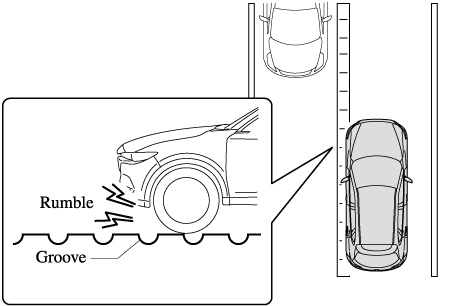
Smart City Brake Support [Forward] (SCBS F) (Some Models)
The SCBS F system alerts the driver of a possible collision using an indication in the display and a warning sound when the Forward Sensing Camera (FSC) detects a vehicle ahead and determines that a collision with a vehicle ahead is unavoidable while the vehicle is being driven at a vehicle speed of about 4 to 80 km/h (2 to 50 mph). In addition, the system reduces damage in the event of a collision by operating the brake control (Smart City Brake Support (SCBS) brake) when the system determines that a collision is unavoidable while the vehicle is being driven at a vehicle speed of about 4 to 30 km/h (2 to 18 mph). It may also be possible to avoid a collision if the relative speed between your vehicle and the vehicle in front of you is less than about 20 km/h (12 mph). In addition, when the driver depresses the brake pedal while the system is in the operation range at about 4 to 30 km/h (2 to 18 mph), the brakes are applied firmly and quickly to assist. (Brake Assist (Smart City Brake Support (SCBS) brake assist))
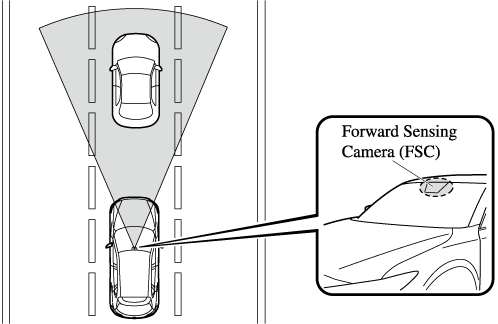
Do not rely completely on the SCBS F system:
-
The SCBS F system is only designed to reduce damage in the event of a collision. Over reliance on the system leading to the accelerator pedal or brake pedal being mistakenly operated could result in an accident.
-
The SCBS F is a system which operates in response to a vehicle ahead. The system may not be able to detect or react to 2-wheeled vehicles or pedestrians.
In the following cases, turn the system off to prevent a mis-operation:
-
The vehicle is being towed or when towing another vehicle.
-
The vehicle is on a chassis roller.
-
When driving on rough roads such as in areas of dense grass or off-road.
Refer to Stopping the Smart City Brake Support [Forward] (SCBS F) system Operation (Search) on how to turn off the SCBS F system.
-
The SCBS F system will operate under the following conditions.
-
The engine is running.
-
The Smart Brake Support/Smart City Brake Support (SBS/SCBS) system warning indication/warning light (amber) does not illuminate.
-
(Rear-end collision warning)
The vehicle speed is about 4 to 80 km/h (2 to 50 mph).
-
(Brake control (Smart City Brake Support (SCBS) brake))
The vehicle speed is about 4 to 30 km/h (2 to 18 mph).
-
The SCBS F system is not turned off.
-
-
Under the following conditions, the SCBS F system may not operate normally:
-
The SCBS F system will not operate if the driver is deliberately performing driving operations (accelerator pedal and steering wheel).
-
If there is the possibility of partial contact with a vehicle ahead.
-
The vehicle is driven on a slippery road surface such as wet roads or icy or snow-bound roads.
-
The braking performance is adversely affected due to cold temperatures or wet brakes.
-
The vehicle is driven at the same speed as the vehicle ahead.
-
The accelerator pedal is depressed.
-
The brake pedal is depressed.
-
The steering wheel is being operated.
-
The selector lever is being operated.
-
-
In the following cases, the Forward Sensing Camera (FSC) determines that there is a vehicle ahead and the SCBS F may operate.
-
Objects on the road at the entrance to a curve.
-
Vehicles passing in the opposite lane while making a curve.
-
Metal objects, bumps, or protruding objects on the road.
-
When passing through a toll gate.
-
When passing through low gates, narrow gates, car washing machines, or tunnels.
-
If you suddenly come close to a vehicle ahead.
-
2-wheeled vehicles, pedestrians, animals or standing trees.
-
Vehicle is driven with some of the tires having significant wear.
-
Margin of Error Between Road Surface on Screen and Actual Road Surface
There might be some margin of error between the road surface appearing on the screen and the actual road surface. A margin of error in the perceived distance could lead to an accident, therefore be aware of the following conditions which can more easily produce errors in the perceived distance.
The vehicle tilts due to weight of passengers and cargo.
If the vehicle is tilted, obstructions picked up by a camera can appear farther or closer than the actual distance from the vehicle.
Front camera

Side camera

Rear camera
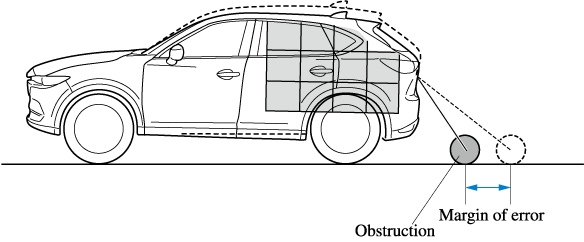
There is a steep up or down grade in the road at the front or rear of the vehicle
If there is a steep up or down grade in the road at the front or rear of the vehicle, obstructions picked up by the camera can appear farther or closer than the actual distance from the vehicle.
Front camera
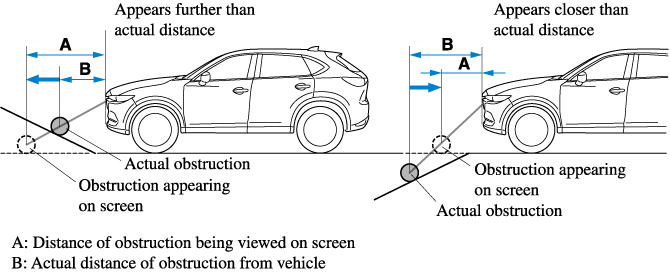
Side camera
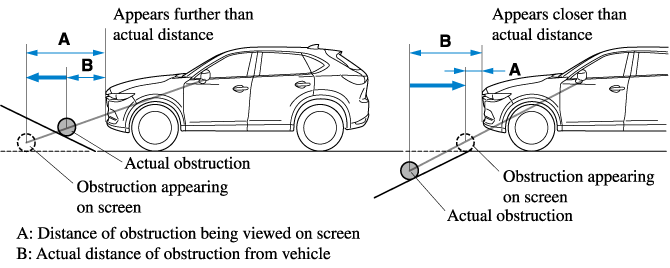
Rear camera
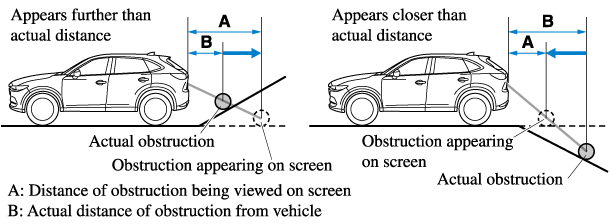
If the vehicle is on a slope, obstructions taken by the camera can appear farther or closer than the actual distance from the vehicle.
Three-dimensional object at vehicle front or rear
Because the vehicle front end guide lines (side camera) or the distance guide lines (rear camera) are displayed based on a flat surface, the distance to the three-dimensional object displayed on the screen is different from the actual distance.
Side camera

Rear camera





















































